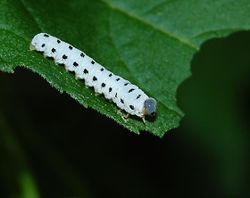
|
The Jedi were real? This article is part of the history of Clan Odan-Urr and isn't part of current events.
Please do not remove this tag or the contents. These articles exist for historic purposes.
|

|
| Cucya-shob
|
|
Insect
|
|
Entheogen
|
|
New Tython
|
|
6 months
|
|
7.6 cm
|
|
15cm
|
|
White
- White and black (Larval stage)
|
|
White
|
|
White
|
- Hallucinogenic compounds
- Religious significance
|
The Cucya-shob, or Eyes of the World as they are known to the Iwu Gioki, are a species of white moth indigenous to New Tython. Hailing from Kamuekiko, these moths live exclusively in secluded caves and glades near the top of the Blue Mountains, and are venerated by the Iwu Gioki both for their sacred white coloring, and for the hallucinogenic visions consumption of their larvae can induce within priests of the Monastic Order of the Optui Turico.
Evolution and History
Thought to have evolved exclusively in the mountain ranges of the Blue Mountains, little is known of the Cucya-shob's origins; they are known to have been dwelling in the Blue Mountains since before the arrival of the Iwu Gioki, prior to which no documented Harakoan settlements existed in the Blue Mountains. Historically, the caterpillars of the species have long been venerated by the Optui Turico, the monastic order of the Gioki, and are consumed in an extremely relevant ceremony restricted to the Optui Turico. Their caves, glades, and secluded nooks have long been seen as holy places by the Turico, and are in fact where the priests are primarily trained in the ways of their religion.
Biology and Description
Cucya-shob begin their life cycles by emerging from clusters of clear, almost crystalline eggs placed amid the mosses and leafy bushes that grow in the Blue Mountain caves they call home. These emerge, and can typically be found adhering to walls or plants as they slowly move about and feed. Three inches long, they are fat as larvae, and have segmented black-and-white bodies that emit and are coated in a toxic secretion that, when properly consumed and not overindulged, induces powerful hallucinations in the Harakoans consuming them. To do so the caterpillars must be boiled, which coaxes secretion of the toxins within to chemically change, and then drained to produce the essential fluid; as it lasts only a few hours before rendering itself inert, it is consumed on the spot, a rite only invoked in times of need or desperation.
 A Cucya-shob larva, used religiously for its hallucinogenic secretions.
A Cucya-shob larva, used religiously for its hallucinogenic secretions.
After two months of life, the Cucya-shob enters a pupal stage, cocooning itself in what seems to be fine white silk as it enters its final gestations. It loses its hallucinogenic qualities and emerges as a snow-white moth. Several of the caterpillars make this change simultaneously, resulting in the chambers of these caterpillars constantly swarming with white moths, a beautiful symbol and one of deep meaning to the Gioki. When the caverns are full, it means fortune smiles on them; when the caves are empty, hard times have come, and should the caterpillars ever disappear it is said by the Gioki that it would be a sign of the end times.
Cucya-shob continue to live as moths for three months; as asexual creatures, they emerge pregnant from their chrysalis, and will produce additional egg sacs before fluttering about the caves. They die in well-known cycles, similarly to how they live, and as these cycles are predictable their clearing is done on a schedule. This task is entrusted only to the leader of the Optui Turico, and is done with a blindfold on, as the Gioki believe that looking on the dead moths will bring misfortune to any who do so.
Behavior
Cucya-shob live simple lives; as caterpillars, they emerge to eat lichen, fungus, and plant life within their caves before undergoing metamorphosis; after this, they will feed off of and propagate pollen within the Oku flowers that grow within their caves, a symbiotic partnership that results in beautiful caves. Because of their significance, harvesting flowers from their caves is strictly forbidden, lest the moth population lose its food source. As asexual creatures, they do not mate, instead going through five life cycles - larval, pupal, pregnant, roaming, and death, all in patterns, as every member of a given egg sac will die off simultaneously with its brethren.
Tribal Politics and Warfare
A simple creature local only to Gioki lands, the Cucya-shob is not particularly impactful upon Tribal politics, though its secrets are fiercely protected by the Gioki and their Virem Guard. As they live in the rugged terrain of the mountains and do not roam, it is thought that their isolation is due strictly to never moving from their homes; thus, if transplanted elsewhere they would likely do well, be it in another cave or in an artificial enclosure. Colonists seek after their hallucinogens to produce stimulants, while other tribes covet the chance to have them as they - like the Gioki - believe the caterpillars can bestow visions of the future.